Affiliate disclosure: This post may contain affiliate links. Please see our Privacy Policy.
Canning beef is a simple way to preserve meat in a shelf stable ready to eat portions. Once the meat is safely pressure canned, just heat and serve, or add to your favorite recipes. Beef can be canned in a variety of ways including as cubes, ground crumbles, formed hamburgers and meat stock, and this beef canning tutorial covers all those options in detail.

This past fall we purchased a half cow share, and that really stretched our freezer space to the limit. With a growing family, buying beef by the side is by far the most economical way to fill the freezer, and next year as my kids grow, I can only imagine needing to add to our stores.
We already make beef jerky, but there’s only so much dried beef you can eat.
Canning beef is a simple way to save on freezer space, while preparing shelf-stable meals in a jar for busy weeknights. You never have to worry about the power going out and spoiling your stores (as is a constant concern with freezer meat).
It’s great for emergency preparedness, but it also tastes great for everyday meals. Pressure canning beef means you’re pressure cooking it (just in jars), and that results in tender flavorful meat that’s already cooked and ready to go. No need to plan ahead and slowly braise the stew beef all day, it’s already waiting for you in a canning jar.
The process for canning beef is pretty much the same as canning any sort of meat, be it pork, lamb, venison, moose, or even bear.
I’ll walk you through how to can beef as:
- Chopped Beef Chunks (both raw pack and hot pack)
- Ground Beef (both as crumbles and formed hamburgers)
- Beef Broth (from trimmings and bones, fully strained)
Beyond these preparations, you may also can beef as stew or chili, and I’ll give you a few recipes for those as well.
(It’s important to note that beef must be pressure canned, and cannot be canned in a water bath canner. If you’re not familiar with pressure canning, I’d strongly suggest reading this beginner’s guide to pressure canning before you get started.)
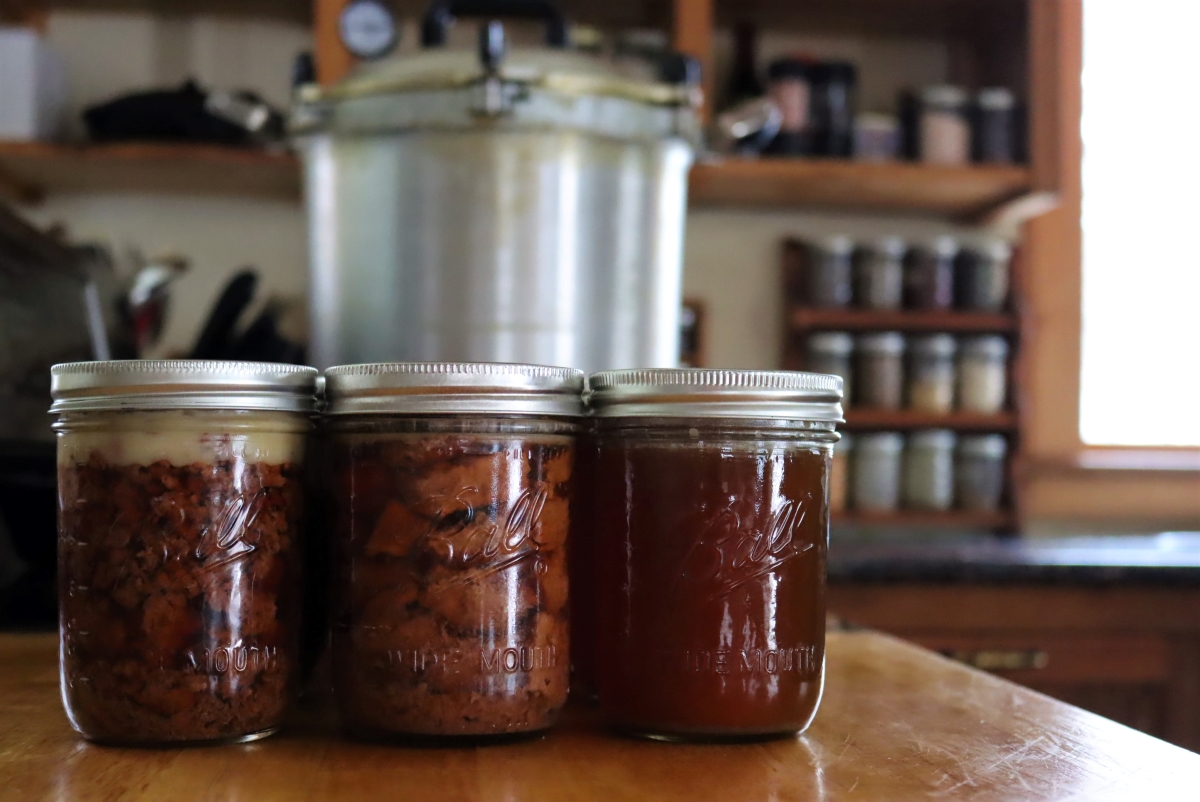
A quick note on yields: I weighed all the meat during this process, and found that on average 3/4 pound (340 grams) of raw beef was required to fill each pint jar. That’s true whether you raw or hot pack, and even if it’s ground or chunks. So for a 9-pint canner batch, you’d need just under 7 pounds of raw meat, regardless of the type of beef and how you chose to pack it.
Canning Beef Chunks
When most people think of canning beef, they assume actual chunks of meat, so that’s where we’ll start. Beef pieces can be canned as strips, cubes or chunks and the National Center for Food preservation gives no restrictions on the size of the pieces. Small roasts or steaks that can fit into jars are perfectly fine for canning, as are smaller beef chunks as I’m demonstrating.
Beef can be packed into canning jars raw (with no liquid), or browned and submerged in your choice of liquid. I’m canning beef in homemade beef stock, but water, meat drippings, and tomato juice are also acceptable options. Adding salt is optional, but if you choose to, somewhere between 1/2 tsp to 1 tsp per pint (double that for quarts) is what’s suggested.
Hot pack (browned) meat results in better quality, but I’ll walk you through both methods.
Raw Pack
When beef is canned “raw pack,” chunks of beef, or small steaks/roasts are packed into canning jars. No liquid is added, as they’ll let out their own juices during cooking.
Modern lean beef cuts don’t tend to let out as much liquid as the beef raised a few decades ago, so raw packing can be problematic. The lack of browning also results in beef that has a “boiled” consistency, without the added flavor and improved texture that browning the meat before canning would provide.
None the less, it’s easy…simply chop the meat as you see fit and pack it into jars leaving 1-inch headspace.
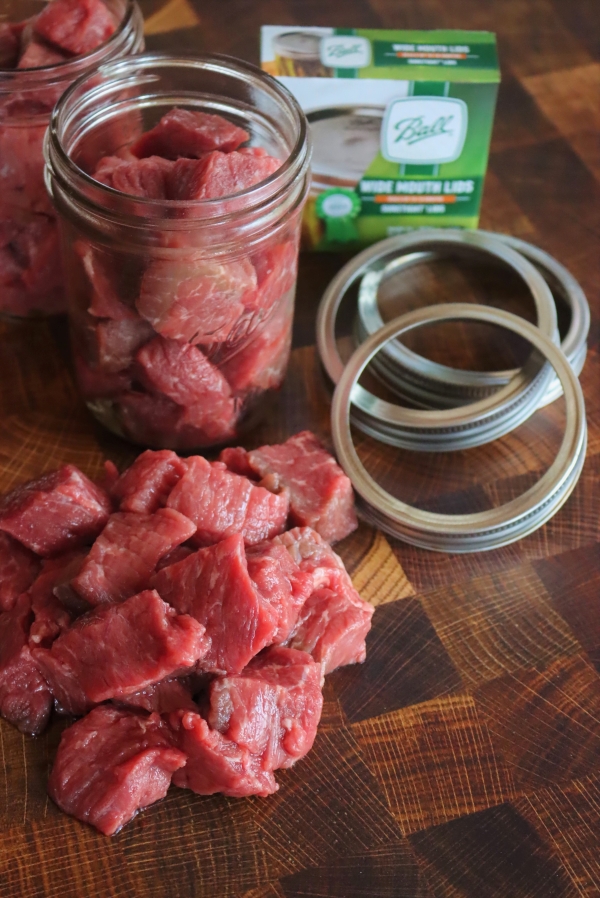
Hot Pack
For hot pack, the beef is browned before loading into jars, which helps the chunks retain shape, and the crisp browned outside adds to both the flavor and the texture of the canned beef. When you’re preparing meat for the crockpot, the result is always better if you take the time to brown the meat before slow cooking, and pressure canning is no different.
Quickly brown the meat on all sides with a little oil (or beef fat) in a hot skillet. There’s no need to cook the meat through, your goal here is simply to put a nice sear on all sides of the beef.
Once the jars are filled with beef, hot pack beef chunks are topped with boiling liquid (water, broth, or tomato juice), while still retaining 1-inch headspace.
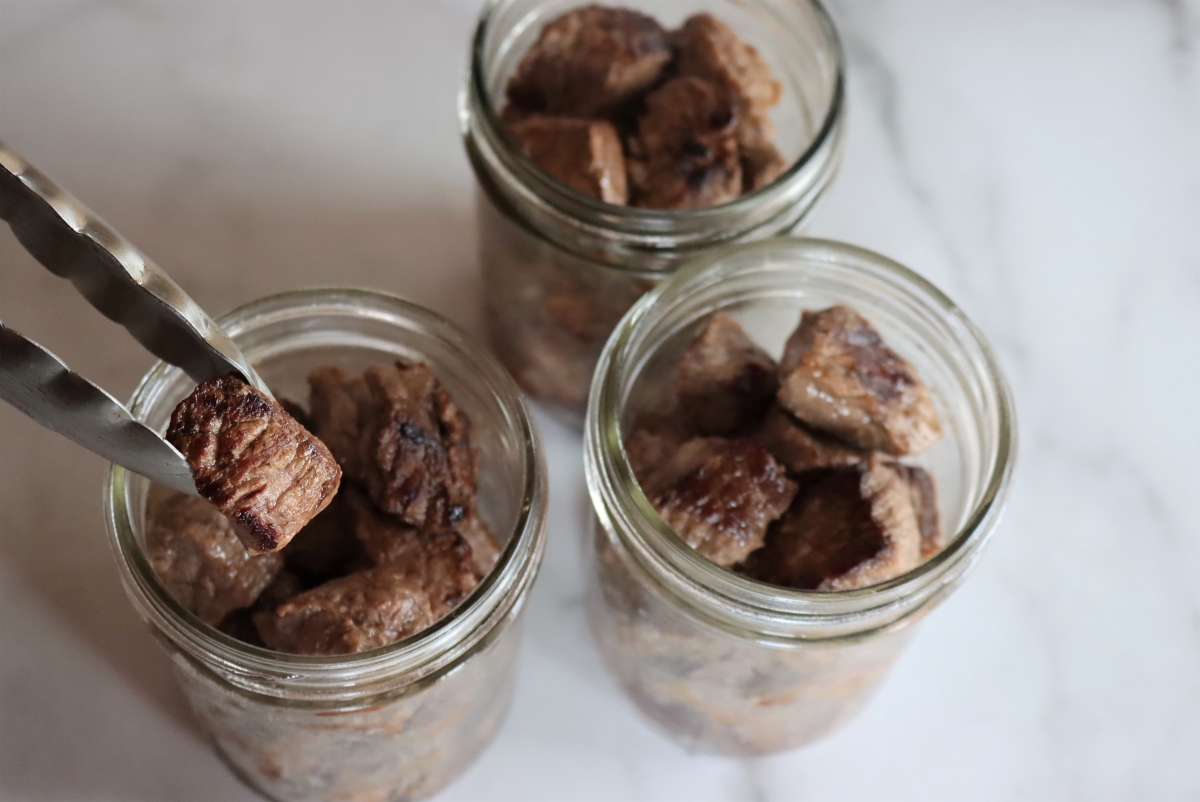
Whether you’ve raw packed or hot packed, the pressure canning instructions are mostly the same, with one key difference. As you’re preheating the pressure canner, you should warm the 2-3 inches of water in the bottom of the canner to roughly 140 degrees F (very hot, but not simmering) for raw pack and 180 degrees F (barely simmering) for hot pack.
It doesn’t have to be exact, and there’s a good bit of wiggle room there, but the idea is to minimize the difference between the temperature of the jars going in and the water in the canner. If you put cold jars in a hot canner they can break from thermal shock.
Load the canner following the manufacturer’s directions, and once it’s up to pressure process the jars for 75 minutes for pints and 90 minutes for quarts.
Adjust the total pressure to your altitude and the type of canner (dial gauge v. weighted gauge) as shown in the table below:
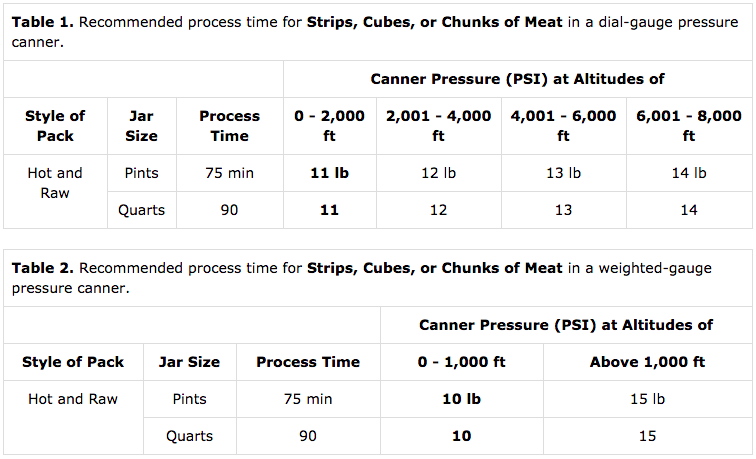
Canning Ground Beef
The process for canning ground beef crumbles, or whole hamburgers, isn’t all that different from canning beef chunks.
Raw pack is no longer an option, and the ground meat must be browned before filling the jars. Browning helps to render out some of the fat, and it also sets the shape of the beef to keep it from packing together into one big loaf in the canning jar.
Though you’re draining fat from the beef, there will still be plenty in the jar, and that’s perfectly fine for canning. You’ll see a thick layer of beef fat at the top of the jar once they’ve cooled, and that’s not only normal it’s perfect for crisping the meat (or burgers) as they come out of the canning jars for serving.
The National Center for Food Preservation actually recommends adding some fat to lean meats like venison, around 1 part pork fat to 4 parts venison, both to help the meat brown and to improve flavor. Ground beef generally has 15 to 20% fat, so it has plenty already.
Ground Beef Crumbles
Canning ground beef crumbles is probably the most versatile method and the simplest. Just brown the crumbles and then pack into canning jars leaving 1 inch of headspace.
The meat may be seasoned with salt, pepper, and spices of your choice before canning. Taco seasoning, for example, is a common choice.
Be aware that some spices don’t can well. Sage and thyme, for example, can get bitter during canning. Other spices, like cumin, can get overbearing after pressure canning. It’s a safer bet to spice the meat at serving time.
If adding salt, 1 teaspoon per pint and 2 teaspoons per quart is a rough guideline.
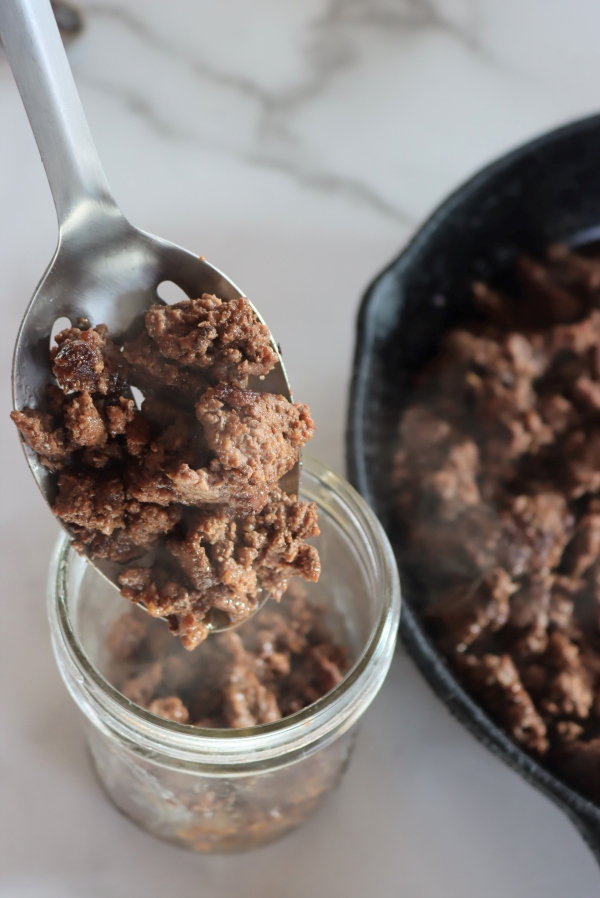
Canning Hamburger Patties
Believe it or not, you can also can whole hamburger patties and they hold up surprisingly well through the canning process. (The same is true for ground pork, which may be canned as patties or links)
For these, I’d recommend salting/seasoning the meat before you form the patties as you won’t be able to season them as easily on serving as the ground beef crumbles.
Just about any salt/seasoning combination is fine for canning, but you cannot use any binders in the meat. No egg, breadcrumbs, or starch of any kind as those are not approved for canning. Stick to meat, salt, and spices.
Shape hamburger patties, knowing that you’ll be able to fit roughly 3/4 pound of meat in the jar. I chose to make three 1/4 pound burgers per wide-mouth pint jar, shaping the burgers to exactly the size of the jar opening.
Be sure to form them well, packing the meat tightly and then brown well on each side so they hold their shape.
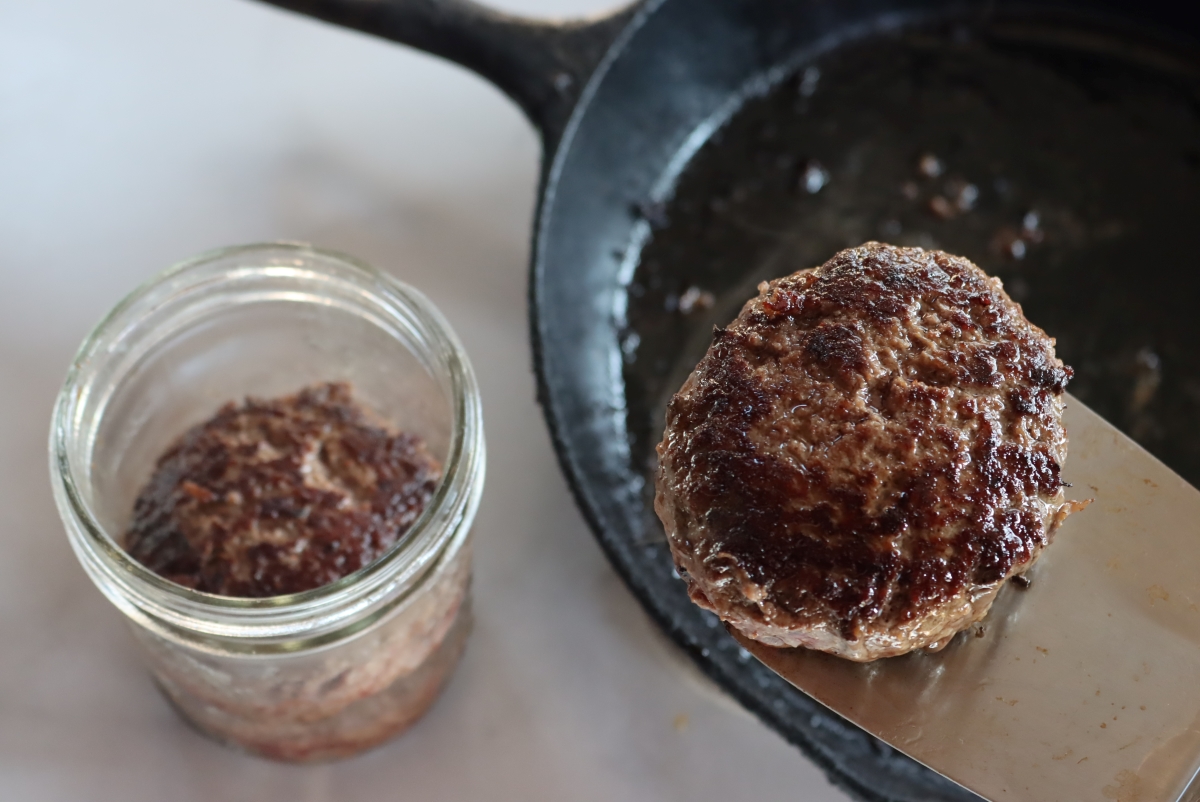
Since all the jars are hot packed for canning ground beef, the process is exactly the same whether it’s loose crumbles or formed hamburger.
Pour boiling stock, water, or tomato juice over the top of the meat in the jars, leaving 1-inch headspace. Seal with 2 part canning lids to finger tight.
Load the jars into a pressure canner that’s been preheated to just barely simmering (around 180 degrees F).
Process in the pressure canner according to the manufacturer’s instructions for 75 minutes for pints and 90 minutes for quarts. This is the same as if canning beef chunks above. Refer to the table below for altitude adjustments.
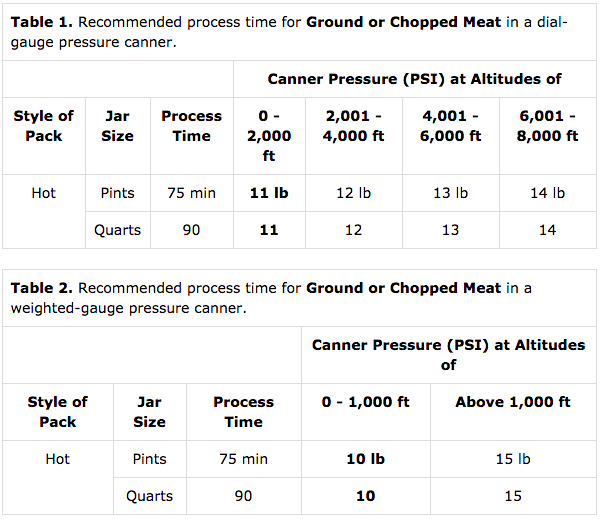
I will admit that canning hamburgers whole is not my favorite preparation. They held together beautifully, which I didn’t expect, but the resulting burgers are quite wet, which makes sense given that they’re canned in broth.
To make them proper hamburgers again, be sure to scoop off the top fat and brown them well in a pan as you’re reheating them. Use your spatula to press down as they cook, trying to press out as much moisture as possible.
A grill also works well for this, as the moisture is able to drip away.
If you’re really conscious of this during re-heating, then you can actually make a totally passable canned hamburger.
Canning Beef Broth
I prefer to can meat of all kinds in meat stock (rather than water) because it prevents the meat’s flavors from leaching out into the canning liquid. If you make an especially rich and flavorful stock, it’ll actually impart flavor to the canned meats (rather than taking it away as water would).
That means that making stock is a part of canning beef, at least in my house.
Canning broth is already part of our normal routine, as the quality is the same as frozen containers of homemade broth and it doesn’t take up any freezer space that way. We must have 8 to 10 gallons of home-canned bone broth in the house at any given time.
None the less, canning beef means making fresh stock (or buying beef bullion), and I’m a fan of making fresh stock as part of the process. If you make a big batch, you can follow up your beef canning round with the second round of beef broth.
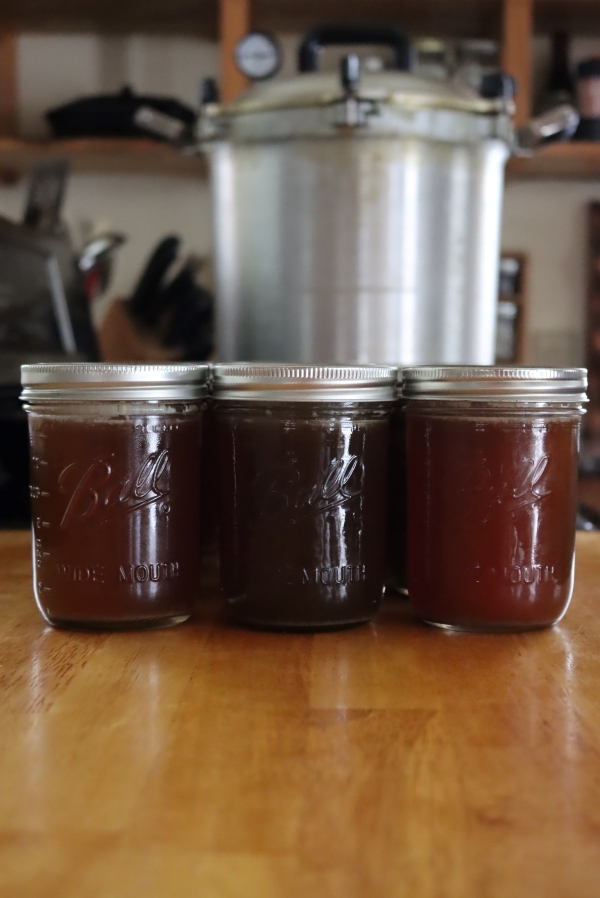
Make the beef broth as you otherwise would, following your favorite recipe, or simply throwing roasted beef bones and bits of meat into a stockpot, simmering slowly for many hours and then straining.
To can beef broth, the timing is much shorter than canning beef chunks because the jars are only filled with liquid rather than broth and meat.
After filtering, reheat the broth to boiling and then fill canning jars with boiling broth, leaving 1-inch headspace.
Process the jars in a pressure canner at pressure for 20 minutes for pints and 25 minutes for quarts. Adjust the pressure based on your altitude following the table below:
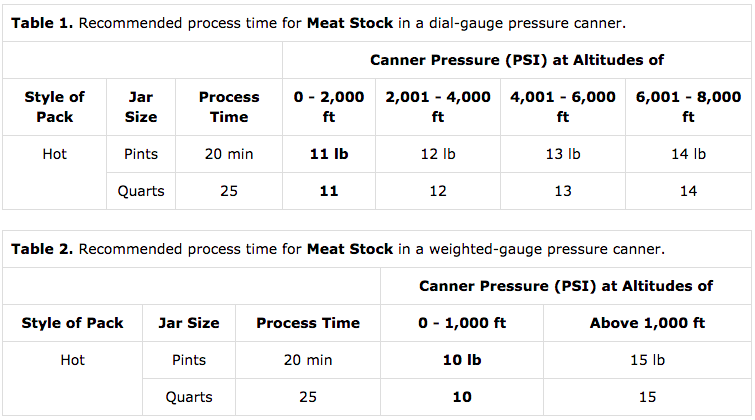
Beef Canning Recipes
Besides canning beef, either plain or seasoned, you can also pressure can chili and soups containing beef. Here are a few recipes that allow you to create shelf-stable meals in a jar:

Canning Beef
Ingredients
- Beef, Either cubed chunks or ground beef
- Canning Liquid, Water, Broth or Tomato Juice
Instructions
- Prepare a pressure canner according to the manufacturers instructions. For most models, this means adding 2-3 inches of water in to the bottom, along with the bottom trivet and then bring it up to a gentle simmer (180 degrees F).
- Brown all meat, whether it’s ground beef, beef cubes or beef strips. Remove the meat from the pan with a slotted spoon, straining out as much fat as possible.
- While the meat is browning, bring canning liquid to a boil and keep it hot. Water, broth and tomato juice are all options, but I generally choose homemade beef broth.
- Pack browned meat into prepared canning jars, either pints or quarts, leaving 1 inch headspace.
- Pour boiling canning liquid over the meat in the jars, still maintaining 1 inch headspace.
- Wipe rims and seal with 2 part canning lids to finger tight.
- Load the jars into your pre-heated pressure canner, seal the lid and allow steam to vent for 10 minutes.
- After steam has vented for 10 minutes, add the canning weight (for weighted guage) to allow the canner to begin coming up to pressure.
- Once the canner is at target pressure (see notes, as the target pressure varies based on your elevation), process the jars for 75 minutes for pints and 90 minutes for quarts.
- After the jars have processed, turn off the heat and allow the canner to cool completely. Once cool, unseal the canner and remove the jars.
- Check seals, remove rings and wash jars. Store any unsealed jars in the refrigerator for immediate use. Sealed jars should maintain quality on the pantry shelf for 12-18 months if properly pressure canned.
Notes
- Under 1,000 Feet Elevation Use 10 lbs
- Over 1,000 Feet Elevation use 15 lbs
- 0 to 2,000 Feet Elevation Use 11 lbs
- 2,001 to 4,000 Feet Use 12 lbs
- 4,001 to 6,000 Feet Use 13 lbs
- 6,001 to 8,000 Feet Use 14 lbs
Pressure Canning Recipes
Looking for more pressure canning recipes?

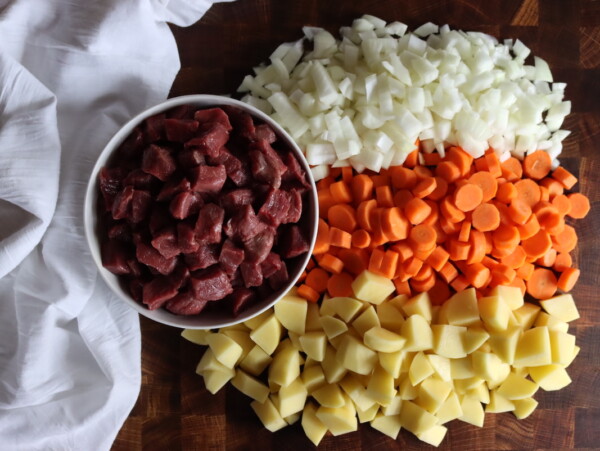
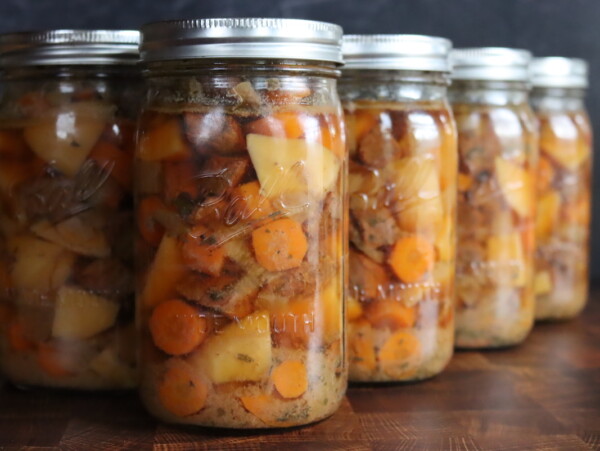
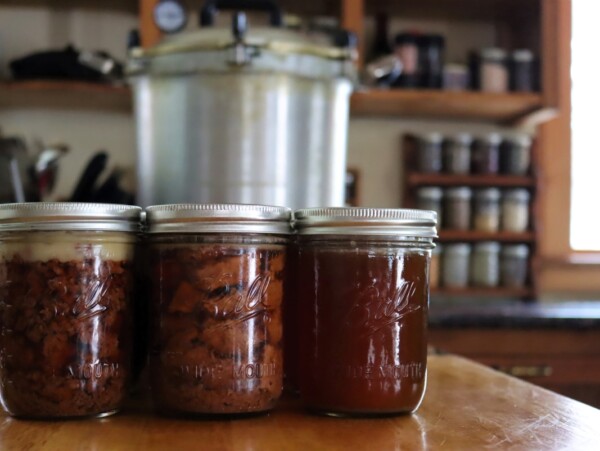










I have canned ground beef and beef sirloin cubes using your instructions topping both with beef boullion. When browning the sirloin cubes I deglazed the pan when needed and added it to the boullion. I love that the meat doesn’t taste like “canned” meat. It is especially helpful to know that a pint takes 3/4 lb! Thank you
Lovely! I’m so glad it was helpful to you!
Very helpful and accurate. One of the best most concise methods Ive read.
Yes browning the meat first is best helps it stay in pieces rather than breaking up when you use it in stews later
and yes even the cheapest toughest cuts of beef are supper tender once pressure canned and to make any dish you only need to cook it long enough for the vegetables you put in
This is a question, not a comment. So I canned some goat meat today. This is my first time canning. I did the cold pack method. The fear I’m having is the “broth” isn’t coving all the meat, do I have to worry about that??? I don’t want to poison me or my wife.
Yes, that’s fine as long as you followed safe canning procedures.